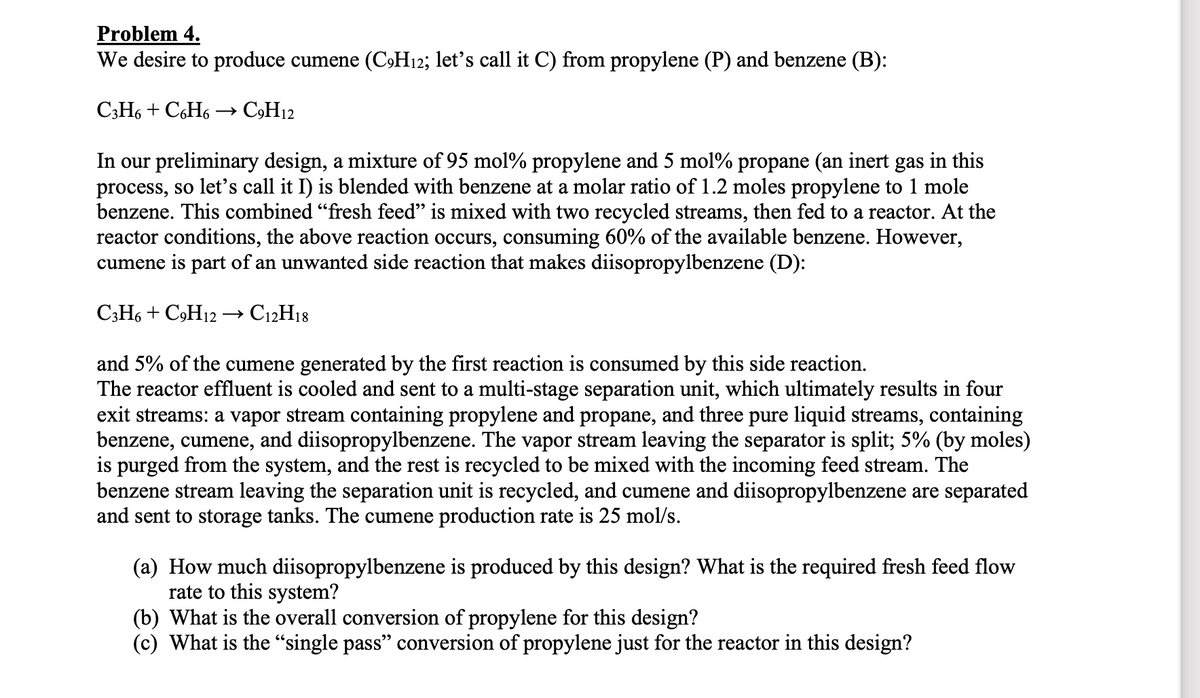C3H6+ C6H6C9H12
Introduction to Chemical Engineering Thermodynamics
8th Edition
ISBN:9781259696527
Author:J.M. Smith Termodinamica en ingenieria quimica, Hendrick C Van Ness, Michael Abbott, Mark Swihart
Publisher:J.M. Smith Termodinamica en ingenieria quimica, Hendrick C Van Ness, Michael Abbott, Mark Swihart
Chapter1: Introduction
Section: Chapter Questions
Problem 1.1P
Related questions
Question

Transcribed Image Text:Problem 4.
We desire to produce cumene (C₂H₁2; let's call it C) from propylene (P) and benzene (B):
C3H6+ C6H6 → C9H12
In our preliminary design, a mixture of 95 mol% propylene and 5 mol% propane (an inert gas in this
process, so let's call it I) is blended with benzene at a molar ratio of 1.2 moles propylene to 1 mole
benzene. This combined "fresh feed" is mixed with two recycled streams, then fed to a reactor. At the
reactor conditions, the above reaction occurs, consuming 60% of the available benzene. However,
cumene is part of an unwanted side reaction that makes diisopropylbenzene (D):
C3H6+ C9H12 → C12H18
and 5% of the cumene generated by the first reaction is consumed by this side reaction.
The reactor effluent is cooled and sent to a multi-stage separation unit, which ultimately results in four
exit streams: a vapor stream containing propylene and propane, and three pure liquid streams, containing
benzene, cumene, and diisopropylbenzene. The vapor stream leaving the separator is split; 5% (by moles)
is purged from the system, and the rest is recycled to be mixed with the incoming feed stream. The
benzene stream leaving the separation unit is recycled, and cumene and diisopropylbenzene are separated
and sent to storage tanks. The cumene production rate is 25 mol/s.
(a) How much diisopropylbenzene is produced by this design? What is the required fresh feed flow
rate to this system?
(b) What is the overall conversion of propylene for this design?
(c) What is the "single pass" conversion of propylene just for the reactor in this design?
Expert Solution
This question has been solved!
Explore an expertly crafted, step-by-step solution for a thorough understanding of key concepts.
This is a popular solution!
Trending now
This is a popular solution!
Step by step
Solved in 3 steps

Recommended textbooks for you

Introduction to Chemical Engineering Thermodynami…
Chemical Engineering
ISBN:
9781259696527
Author:
J.M. Smith Termodinamica en ingenieria quimica, Hendrick C Van Ness, Michael Abbott, Mark Swihart
Publisher:
McGraw-Hill Education

Elementary Principles of Chemical Processes, Bind…
Chemical Engineering
ISBN:
9781118431221
Author:
Richard M. Felder, Ronald W. Rousseau, Lisa G. Bullard
Publisher:
WILEY

Elements of Chemical Reaction Engineering (5th Ed…
Chemical Engineering
ISBN:
9780133887518
Author:
H. Scott Fogler
Publisher:
Prentice Hall

Introduction to Chemical Engineering Thermodynami…
Chemical Engineering
ISBN:
9781259696527
Author:
J.M. Smith Termodinamica en ingenieria quimica, Hendrick C Van Ness, Michael Abbott, Mark Swihart
Publisher:
McGraw-Hill Education

Elementary Principles of Chemical Processes, Bind…
Chemical Engineering
ISBN:
9781118431221
Author:
Richard M. Felder, Ronald W. Rousseau, Lisa G. Bullard
Publisher:
WILEY

Elements of Chemical Reaction Engineering (5th Ed…
Chemical Engineering
ISBN:
9780133887518
Author:
H. Scott Fogler
Publisher:
Prentice Hall


Industrial Plastics: Theory and Applications
Chemical Engineering
ISBN:
9781285061238
Author:
Lokensgard, Erik
Publisher:
Delmar Cengage Learning

Unit Operations of Chemical Engineering
Chemical Engineering
ISBN:
9780072848236
Author:
Warren McCabe, Julian C. Smith, Peter Harriott
Publisher:
McGraw-Hill Companies, The